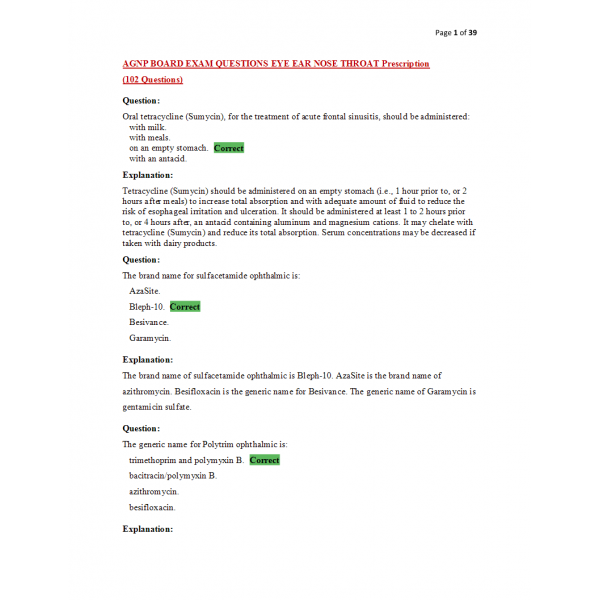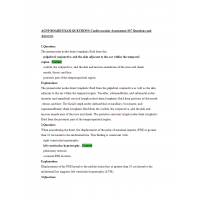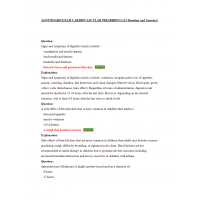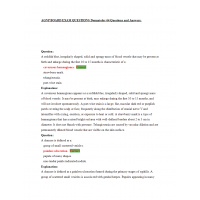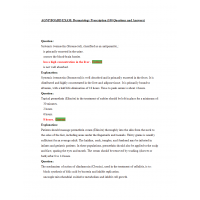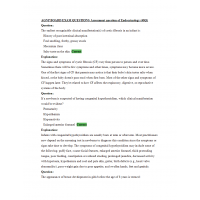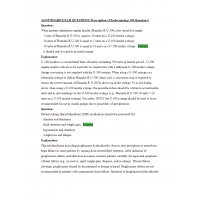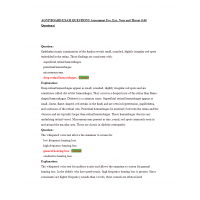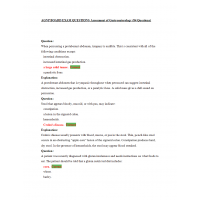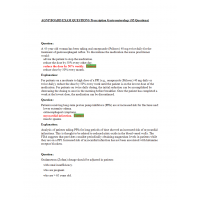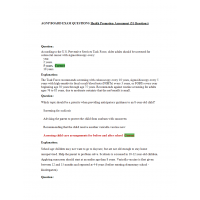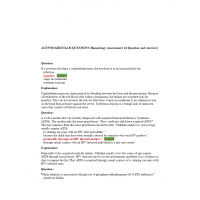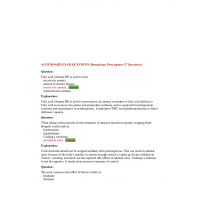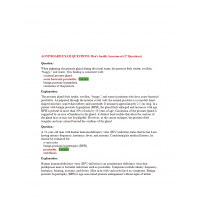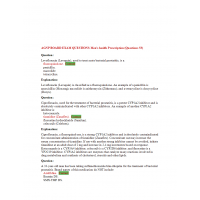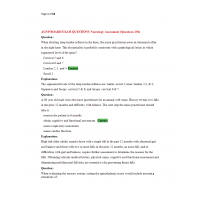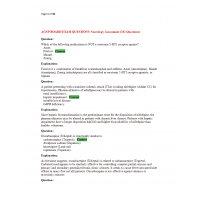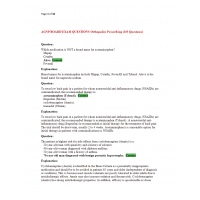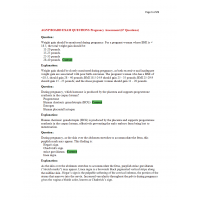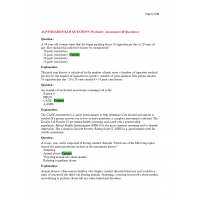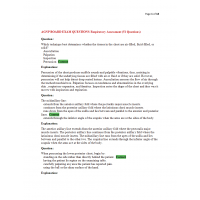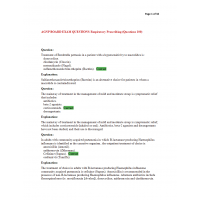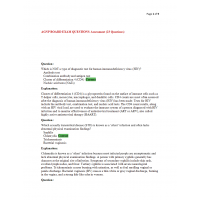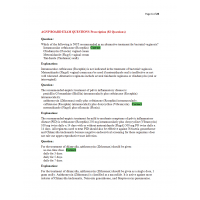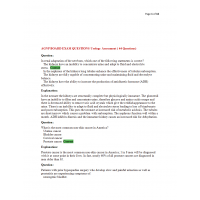AGNP BOARD EXAM QUESTIONS EYE EAR NOSE THROAT Prescription (102 Questions)
1. Oral tetracycline (Sumycin), for the treatment of acute frontal sinusitis, should be administered:
2. The brand name for sulfacetamide ophthalmic is:
3. The generic name for Polytrim ophthalmic is:
4. Which of the following does NOT cause a drug-disease interaction when using a decongestant/antihistamine medication such as Naphazoline/pheniramine (Naphcon-A)?
5. The maximum daily dose of acetaminophen for ages 12 years and older is:
6. For treatment of blepharitis, patients should be instructed to apply erythromycin ointment to the affected eye using:
7. Ophthalmic cromolyn inhibits the degranulation of sensitized mast cells. It is indicated in the treatment of:
8. The most effective treatment for eradication of group A streptococcus in those who are apparent carriers is:
9. The generic name for Dramamine is:
10. For empiric treatment of patients with acute bacterial rhinosinusitis (ABRS) who are allergic to penicillin, the best alternative first-line therapy is:
11. Dosing of oseltamivir (Tamiflu) for adults and adolescents with active influenza is administered orally:
12. The vasoconstrictive properties of alpha-1 agonist medications make them beneficial for the treatment of:
13. The use of oral acyclovir (Zovirax) in older adults is more likely to cause:
14. Cephalosporins are classified as:
15. The onset of action of oxymetazoline (Afrin) is:
16. Erythromycin (Ilotycin) ophthalmic ointment is classified as a(n):
17. A common side effect of amoxicillin in children is:
18. The first-line antibiotic for acute otitis media in a child with a potential for beta-lactam resistance is:
19. The ophthalmic preparation that is NOT available over the counter is:
20. Refractory blepharitis is best treated with:
21. A serious adverse reaction to clindamycin (Cleocin) is:
22. Which of the following is NOT a potential adverse effect of sulfacetamide ophthalmic (Bleph-10) for the treatment of acute conjunctivitis?
23. The preferred class of oral antibiotic therapy for blepharitis with visual impairment is:
24. Ocular steroids indicated for the treatment of allergic conjunctivitis can be used in patients with:
25. The brand name for meclizine is:
26. Oxymetazoline nasal spray, a nasal decongestant, is manufactured under the brand name:
27. The most effective method to minimize dizziness associated with the administration of otic solutions is to:
28. Intranasal antihistamines are indicated in the treatment of:
29. Due to potential drug-drug interactions, therapy should be monitored when a patient is receiving erythromycin (Eyemycin) ointment and:
30. When prescribing polymyxin B sulfate/bacitracin zinc (Polycin-B), patients should be instructed to:
31. Ceruminolytics are safe to use in patients with history of:
32. Polymyxin B/trimethoprim ophthalmic is NOT indicated for:
33. A common side effect of azelastine (Optivar) ophthalmic drops used for allergic conjunctivitis is:
34. If ocular steroids are to be used for more than 10 days, monitoring should include:
35. Oxymetazoline (Visine-LR) is an ophthalmic:
36. Potential adverse reactions of glucocorticoid nasal sprays do NOT include:
37. The mechanism of action of trifluridine (Viroptic), an ophthalmic antiviral, used in the treatment of herpes simplex conjunctivitis is:
38. After the administration of olopatadine (Pataday) ophthalmic for allergic conjunctivitis, contact lenses should not be inserted for at least:
39. The duration of action of meclizine (Antivert) is:
40. A common side effect of oral phenylephrine (Sudafed), a decongestant, is:
41. Polycin-B is the brand name for:
42. Naphazoline/pheniramine (Naphcon-A) is indicated in the treatment of:
43. An example of a drug that is a cholinergic agonist is:
44. Bacitracin (Ocu-Tracin) ophthalmic ointment inhibits bacterial cell wall synthesis by:
45. Which risk factor would NOT prohibit the nurse practitioner from prescribing prednisolone acetate (Pred Forte)?
46. The duration of action of ocular decongestants such as oxymetazoline (Visine-LR) is approximately:
47. Systemic absorption of ocular decongestants, such naphazoline (Naphcon) may cause:
48. A common side effect related to the administration of cetirizine (Zyrtec) is:
49. Patients being treated with trifluridine (Viroptic) for herpes simplex 1 keratoconjunctivitis should be advised to return to the clinic if they do not experience symptom improvement within:
50. Which of the following organisms is NOT susceptible to sulfacetamide ophthalmic (Bleph-10)?
51. Which patient should be closely monitored for systemic effects of prolonged ocular steroid therapy?
52. Penicillins are primarily prescribed for the treatment of infections caused by:
53. The mechanism of action for mast cell stabilizers is:
54. For patients who anticipate exposure to a specific known eye allergen, such as pollen, the best preventive therapy is a topical ophthalmic:
55. Tetracyclines should be avoided in patients who are allergic to:
56. The standard concentration of acetaminophen liquid for pediatric use is:
57. Second-generation antihistamines:
58. Long-term or repeated use of polymyxin B/trimethoprim ophthalmic drops may cause:
59. After instilling ophthalmic drops, patients should be instructed to hold pressure to the medial punctum and nasolacrimal sac. The purpose of this is to:
60. The mechanism of action for macrolides is to:
61. The mechanism of action for meclizine (Antivert) is to:
62. Brand names of sulfamethoxazole/trimethoprim do NOT include:
63. Dosing of oseltamivir (Tamiflu) for older adult patients with active influenza and a creatinine clearance between 30-60 mL/min is:
64. The mechanism of action of pheniramine is that it:
65. Which of the following is a cholinergic agonist used in the treatment of glaucoma?
66. The correct method for instilling ophthalmic ointments is to:
67. Erythromycin (Ilotycin) ophthalmic ointment is NOT indicated in the treatment of:
68. A patient is receiving amoxicillin (Amoxil) for the treatment of otitis media. A hypersensitivity reaction would present with symptoms of:
69. An alternative treatment for a child who has Strep throat and who has had a Type I hypersensitivity reaction to penicillin is:
70. Patients should be advised to administer polymyxin B/trimethoprim every:
71. Penicillins are primarily prescribed for the treatment of infections caused by:
72. First-line treatment for children who are diagnosed with Strep pharyngitis is:
73. The most common symptoms of penicillin allergy include hives, itchy eyes, and:
74. Patients and caregivers should be advised to stop oseltamivir (Tamiflu) and notify the provider immediately if the patient develops:
75. Azelastine (Astelin), for treatment of allergic rhinitis, is classified as a nasal:
76. A benefit of prescribing an ophthalmic antihistamine with a mast cell stabilizer property would be that the mast cell stabilizer provides:
77. The best topical antibiotic choice for the treatment of acute blepharitis is:
78. Ocular decongestants such as oxymetazoline (Visine-LR) are used to reduce:
79. The mechanism of action of polymyxin B/trimethoprim ophthalmic is:
80. Patients who are using a glucocorticoid nasal spray should be advised to:
81. When a patient must administer more than one ophthalmic medication, they should be instructed to administer the drops:
82. Which of the following is classified as a second-generation antihistamine?
83. A patient is diagnosed with group A Streptococcus pharyngitis. The best choice for antimicrobial therapy is a:
84. The brand name for cetirizine is:
85. Sulfacetamide/prednisolone (Blephamide) is NOT indicated in:
86. Prolonged use of bacitracin ophthalmic may result in:
87. The most effective treatment for allergic rhinitis is:
88. The generic name of Pataday ophthalmic drops used in the treatment of allergic conjunctivitis is:
89. A medication that acts on the hypothalamus to produce antipyresis is:
90. The appropriate duration of oral penicillin for a patient who has been diagnosed with group A Streptococcus pharyngitis is:
91. The most effective treatment for eradication of group A streptococcus in those who are carriers is:
92. The generic name for Restasis is:
93. The generic name for AzaSite ophthalmic drops is:
94. Which of the following is NOT a mechanism of action of ocular steroids?
95. Due to the potential development of pseudo tumor cerebri, tetracycline (Sumycin) should not be administered concomitantly with:
96. The most important caution when prescribing aminoglycosides for treatment of otitis externa is:
97. The duration of action of azelastine (Optivar) ophthalmic drops is:
98. A 38-year-old man has been receiving oral tetracycline for the treatment of refractory blepharitis. The patient should be referred to ophthalmology if experiencing:
99. The brand name of prednisolone acetate ophthalmic is:
100. Which of the following is NOT an antihistamine?
101. The LEAST concerning side effect of first-generation antihistamines (i.e., dimenhydrinate) in patients older than 65 for the treatment of vertigo is:
| Institution & Term/Date | |
| Term/Date | AGNP Exam |
AGNP Board Exam Question and Answers Eye, Ear, Nose, Throat Prescription
- Product Code: 2020
- Availability: In Stock
-
$45.00

